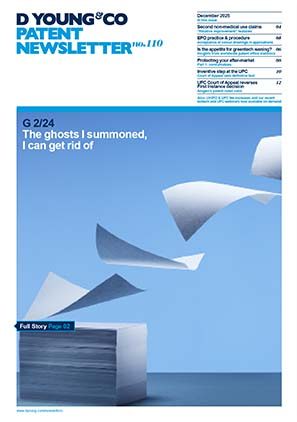G1/19 - comments by the President of the EPO
In our October 2019 newsletter, we discussed the G/19 referral on simulation inventions to the Enlarged Board of Appeal at the European Patent Office [see note 1 below]. As discussed in the article, G/19 is of potentially huge significance in the field of computer-implemented inventions due to the potential effect on clarifying the boundary between excluded and non-excluded inventions. That this field is extremely “hot” right now is demonstrated by the large number of amicus curia briefs submitted in respect of this referral, at last count over 20.
Update 24 March 2021
The EPO Enlarged Board of Appeal has issued its decision in G1/19. Link to read our commentary including a review of the answers, guidance and implications of this decision.
Read moreWhile some level of third party amicus curiae interest is common for referrals in front of the Enlarged Board of Appeal, for the present referral we have the unique situation of additionally having “Comments” direct from the President of the EPO.
Background
By way of background, the application in question concerns the modelling of “pedestrian behaviour” through a simulated environment. Crucially, the claims did not contain either direct “input” from a real-world environment/building or “output” to the real-world, for example, using the modelling to inform a design of an environment/building.
In the decision of the first instance Technical Board of Appeal (T489/14), the Technical Board of Appeal found that: “a technical effect requires …a direct link with physical reality, such as a change in or measurement of a physical entity.”
Accordingly, the Technical Board of Appeal found that modelling pedestrian behaviour through a simulated environment, as it had no link with physical reality, was non-technical and hence excluded from patentability.
The Technical Board of Appeal did, however, acknowledge that there was a divergence in the case law and for that reason referred three questions to the Enlarged Board of Appeal which form the basis of G1/19.
Question 1
In the assessment of inventive step, can the computer-implemented simulation of a technical system or process solve a technical problem by producing a technical effect which goes beyond the simulation’s implementation on a computer, if the computer-implemented simulation is claimed as such?
In answering this question, the President began by immediately criticising the “direct link with physical reality” finding, noting that the EPO Examination Guidelines are littered with examples of inventions which have previously been found to be technical despite having no obvious link to physical reality. Examples occur in the fields of computer graphics, speech synthesis and cryptography.
The President went on to confirm that, in his assessment, the standard problem and solution approach coupled with the COMVIK [see note 2 below] guidance on how to tackle mixed technical/non-technical inventions is the appropriate approach to answering the referral questions.
In applying this approach, the President noted that a crucial factor is whether the design of the claimed invention “requires the technical knowledge of a person skilled in the technical field”. The President considered that it was unfair to allow technical knowledge to be included in the requirements specification provided to the notional skilled person, as this would prevent technical aspects from supporting an inventive step under the COMVIK guidance
The President went on to comment that simulations which reflect technical principles underlying the simulation actually provide an approximate imitation of the simulated operation, irrespective of any direct input or output, and hence gives information about the technical properties of the simulated system.
As such, the President concluded that the first question could be answered as follows: “a computer-implemented simulation of a technical system or process claimed as such solves a technical problem by producing a technical effect going beyond the computer-implementation when it reflects, at least in part, technical principles underlying the simulated system or process.”
Question 2
If the answer to the first question is yes, what are the relevant criteria for assessing whether a computer-implemented simulation claimed as such solves a technical problem? In particular, is it a sufficient condition that the simulation is based, at least in part, on technical principles underlying the simulated system or process?
In the comments, the President states that he considers this question largely answered by his detailed discussion of question 1. In brief, however, the President summarises his stance on question 2 as: “A sufficient condition for a computer implemented simulation of a technical system or process claimed as such to solve a technical problem going beyond the simulation’s implementation on a computer is that the simulation method reflects, at least in part, technical principles underlying the simulated system or process.”
Question 3
What are the answers to the first and second questions if the computer-implemented simulation is claimed as part of a design process, in particular for verifying a design?
Finally, in respect of the third question, the President merely states that “In view of the answers proposed in these comments to the first and second questions, the third question does not appear to require a separate answer.”
Conclusion
It is very encouraging to see the EPO President taking an active role in helping to ensure that the Enlarged Board of Appeal comes to a well-reasoned decision in such an important area. Regarding the President’s motivation for taking such an active role it is interesting to note that over the last year Andrei Iancu, the Director of the USPTO, has produced some detailed guidance for US patent examiners on subject matter eligibility which may have acted as a source of inspiration and recognition that this is an important topic on both sides of the Atlantic.
The Enlarged Board of Appeal is presently considering the appeal but we are hopeful that they will reach their final decision in early 2020.
Notes
- See “G1/19: Enlarged Board of Appeal to consider the patentablity of computer-implemented inventions “ by Simon Davies, 24 October 2019: https://dycip.com/g1-19-eba-ci... COMVIK approach was first introduced in the landmark decision T 0641/00. Only the features in the patent claim which contribute to the solution of a technical problem are taken into account in the inventive step assessment, whereas the non-technical features are ignored.

